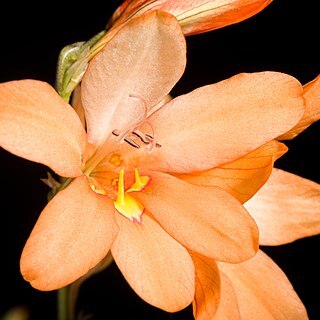Plants (50-)80-150(-200) mm high. Corm conical-globose, 5-10 mm diam.; tunics of fine-textured fibres, extending in a papery or fibrous neck. Stem suberect or deflexed above uppermost sheath, usually unbranched, rarely with 1 branch from near base. Leaves 4 to 8, linear, flaccid, suberect or spreading to trailing, usually ± as long as stem or longer, 50-150(-200) x (0.5)1.0-2.0(-3.0) mm wide, acute to acuminate, main vein moderately thickened, margins slightly thickened, cauline leaf membranous, bract-like, sheathing, concealed by uppermost foliage leaf. Spike inclined, moderately lax, 2-to 6-flowered; bracts dry-membranous, translucent flushed brown and speckled in upper 1/2, 5-9 mm long, minutely 3-toothed, inner shortly bifid. Flowers zygomorphic, reddish orange to salmon-orange with yellow throat and yellow spot on lower tepals surrounding callus; perianth tube obliquely funnel-shaped, 6-10(-13) mm long, lower cylindric portion 3-6 mm long, widening above to 6-8 mm diam.; tepals obovate, dorsal larger and slightly hooded over anthers, often paler inside, upper laterals spreading, lower tepals deflexed, upper tepals 11-15 x 6-10(-12) mm, lower tepals 8-10 x 4-6 mm, each with a quadrate yellow callus 1-2 mm diam. near base, calluses on laterals sometimes smaller than median. Filaments unilateral, arcuate or sometimes slightly divergent, 6-10 mm long, exserted up to 4 mm; anthers 4-5 mm long, often curved, violet to red-purple. Style dividing opposite middle to tips of anthers, branches 2-3 mm long. Capsules shortly ellipsoid, ± 6 mm long.
More
Perennial herb, geophyte, 0.15-0.25 m high; corm ovoid, tunics of coarse, reticulate fibres; stem flexuose, usually simple. Leaves linear, 1-4 mm wide, acuminate, suberect. Bracts membranous, straw-coloured with brown veins, outer minutely tridentate, inner bidentate. Inflorescence a spike; flowers bilabiate, reddish to orange; throat yellow; perianth tube 6-12 mm long, tubular in lower half; tepals 9-12 mm long, oblanceolate, obtuse, dorsal concave, hooded; lower with yellow, tooth-like callus. Stamens curved; filaments 6-10 mm long; anthers 4-5 mm long, curved, often violet. Style 10-20 mm long. Flowering time Sept., Oct. Capsule ellipsoid.
Like T. securigera but leaves linear, 1-4 mm wide and lateral calluses sometimes reduced.

